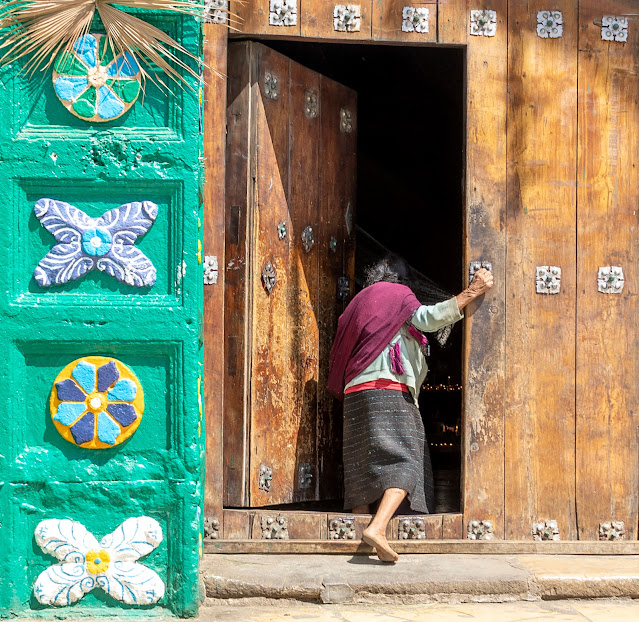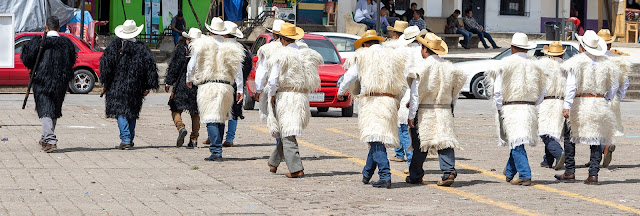Our itinerary said we were then going to visit local Maya communities which I’d assumed would be remote villages. However San Juan Chamula is a municipality only about 10kms from San Cristobal, albeit a very, very different place. Virtually the entire c75,000 population is indigenous and speaks an indigenous language; the vast majority being Tzotzils.
I know that many Maya people dislike having their photographs taken, whether they believe it somehow steals their soul or they simply don't like it (as I wouldn't), but this community goes one step further. Francisco gave us very stern warnings on the bus regarding taking pictures in this town; only with permission should we overtly photograph anyone and to be very careful not to be caught doing it covertly. However in the church we would be visiting DO NOT TAKE ANY PHOTOS WHATSOEVER as mostly likely the camera would be snatched from us and smashed on the ground, also physical violence against the photographer wasn’t unknown, as well as a very hefty fine.
The bus parked on the edge of town and we had about a 1km walk down to the main plaza and church. There were lots of flower stalls all around with these beautiful displays but, having heard Francisco's dire warnings, I was almost too scared to even switch my camera on and so I only took a few.
I think it'll take more than a quick lick of paint to make these habitable.
After the Spanish conquistadores arrived in Mexico in the 16th century they built many such churches and tried to convert the indigenous population to Christianity. Quite often the only alternative to accepting this new religion was death and so many pretended to convert, but actually retained their own pagan beliefs and over the generations blended their traditional rituals with the Catholics and adapted the church buildings to fit their purposes.
Iglesia de San Jan Bautista (St John The Baptist Church) was built in 1522-24 and looks a perfectly ordinary Spanish church from the outside, painted white and beautifully decorated with flower symbols.




The extraordinary sights we were soon to witness are probably some of the most extreme examples of pagan practices still in existence and, as controversial as they are, they reflect the Maya people’s will to survive the colonial invasion.
Stepping in through the small door the air was thick with smoke from 1000s upon 1000s of candles burning in groups on the floor, which itself was covered in pine tree needles. I'd expected a "normal" interior but all the pews and confessionals had been removed, although the main altar was still there. Around the walls were statues of Christian saints in wooden cabinets, in front of which were tables with yet more burning candles on each and many, many flower arrangements. The smell of pinewood, flowers and incense was almost overpowering. The place was crowded with people of all ages; some alone, others in family groups, some standing and some sitting on the floor - I have never seen anything like it before.
Maya people believe in the spirit world and consult shamans (aka curanderos) about every aspect of their lives. The shamans act as mediums between the physical and the spirit world and in simple terms tell the people how they can rid themselves of the evil spirits that are plaguing them - an extremely simplistic view I know, but I can't think how else to describe it.
The Tzotzil people we saw in their church today would have visited their shaman and been told what to bring to the church as an offering. We saw candles of various colours, bottles of Coca Cola and Fanta (other fizzy drinks are available!), a strong alcoholic drink called Pox pronounced "Posh", baskets of eggs and even live chickens being carried in. Sometimes their own shaman accompanies them and performs the ritual but some consulted one of the many "resident" shamans.
Francisco had tried to describe to us what we might see and his scenario involved curing an illness so that's what I'm going to repeat here:
Firstly candles of the prescribed colour are lit and there is lot of chanting going on. Then the Pox and fizzy drink are consumed in large quantities as burping is believed to expel bad spirits from the body. Sometimes a raw egg is stroked over the body as that is believed to absorb the evil and, if that doesn't work, then a chicken is waived over the person - and then the chicken’s neck is wrung because it then contains the evil spirit!
Then all the melted wax is scraped up, the pine needles are replenished and the next troubled person(s) sits down.
Apparently the egg has long been regarded as the a symbol of life and growth and I suppose as an egg comes from a chicken, the chicken is the ultimate power?
It was absolutely fascinating to see, but at the same time I really felt like I was intruding. Of course I didn't take any pictures, but I found these online to give an you idea, although it was considerably more crowded when we were there.
Blinking back out in the sunshine I felt if this lady was going to sit at the base of the cross she really was fair game for a photo.

"A Millennium is born, we reaffirm the faith"
A sneaky back view and you can just about see the candles on the floor inside.
The same with this one, sit at the bottom of a statue and you'll be photographed. I think this was a statue of a former mayor or someone.
Francisco was busy explaining to us that the town enjoys unique autonomy within Mexico and Chamulas even have their own police force with no outside police or military being allowed in the town. As he was speaking, hoards of men suddenly streamed out of the town hall - it must be lunchtime! Given the sensitivity to photography here I thought it prudent to wait until they were well past me before daring to take any shots.
The ones in white are the council officials, I think, whereas the black ones are the armed escort - just look at the long wooden poles they carry - for beating people around the legs apparently.
Walking back out of town to the bus I was slightly braver; I asked and was given more than a nod of ascent!
I think I've correctly identified this as a Prickly Chayote Squash but, apart from the fact that it's native to Mexico and favoured over Smooth Chayote Squash, I've not found any useful info.
We've see a lot of people, particularly men, carrying huge loads on their backs using these head straps.
Back up to the bus and florist land offering floral arrangements for Weddings, 15th Birthday(?), First Communions, Funeral Wreaths and every type of event
























